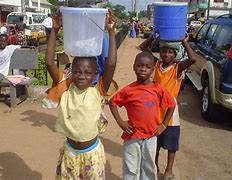by Anwuli Oseloka

Child hawking, the practice of children selling goods on the streets instead of attending school or engaging in age-appropriate activities, is a persistent issue, particularly in urban areas like Ikeja. Addressing child hawking in urban settings requires a multifaceted approach that acknowledges the unique challenges these environments present and offers comprehensive solutions to protect vulnerable children.
IkejaBird went out talking with these children and observed most of them often find themselves caught in the cycle of poverty, exploitation, and lack of opportunities leading them to the streets.
“I go to school, but after school, me and my brother come and sell pure water to help our mummy”. She also sells pure water too,” Shola said.
Anthony is another child selling groundnuts to cars caught in traffic, “I stopped going to school because they are always sending us home from school because no money for school fees. I still want to go to school but I have to help my mummy. She has a shop so this is what I can do to support.”
This is also the case for Tade, “I finished JSS 3 but I have younger ones too in school, and I am the first child so I have to start doing business like my parents to support. They have tried to get me to secondary school so if I do this hawking, I will bring small money home too and it makes me happy.”
When asked about being exploited by street gangs he said, “I see them but I don’t talk to them, I know if I sell to them most of them won’t pay so I avoid anywhere I see them and face customers in traffic.”
In as much as this is not safe for these children, it can be seen that the major reason for children hawking is poverty.
Urban poverty is a driving force behind child hawking. Many families living in urban areas struggle to make ends meet, leading parents to send their children to work on the streets to supplement household income.
Another issue is access to education. Despite the presence of schools in urban areas, many children engaged in hawking are unable to attend due to financial constraints, lack of transportation, or other barriers. This perpetuates a cycle of illiteracy and limited opportunities for future advancement.

Another concerning issue is the exploitation and vulnerability these children face. Children engaged in hawking are often exploited by traffickers, street gangs, or unscrupulous employers who take advantage of their vulnerability. They may be subjected to physical and emotional abuse, coercion, and unsafe working conditions.
We, at Ikejabird believe if the government can launch targeted campaigns to raise awareness about the harmful effects of child hawking and the importance of education can help shift societal attitudes and behaviors. These campaigns should engage parents, communities, and policymakers to promote alternatives to child labor.
Educational bodies in collaboration with the government can improve access to education by providing scholarships, school supplies, and transportation subsidies. This can help remove barriers preventing children from attending school. Schools should also be equipped with resources to support children who have fallen behind academically due to hawking.
Addressing the root causes of child hawking requires initiatives aimed at poverty alleviation and economic empowerment. Providing vocational training, microfinance opportunities, and job placement services to parents can reduce reliance on child labour as a means of income generation.

Also, building strong community networks and partnerships with local organizations can facilitate the identification and support of child hawkers. Community-based interventions, such as counseling, rehabilitation programs, and access to healthcare, are essential for addressing the physical and psychological needs of these children.
Finally, enforcing existing child labor laws and implementing specific regulations targeting child hawking are crucial steps in combating the practice. This includes penalties for employers who exploit child hawkers and mechanisms for rescuing and reintegrating children into safe environments.
In conclusion, addressing child hawking in urban areas requires concerted efforts from governments, civil society organizations, communities, and individuals. By tackling the underlying factors driving child hawking and implementing holistic solutions that prioritize education, protection, and empowerment, we can create safer and more equitable environments for urban children to thrive.







